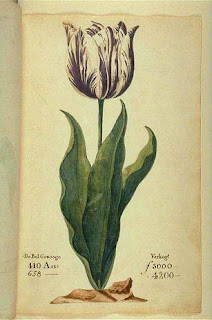Bunga tulip memang cantik dan bermacam -macam warna. Kat bawah ni ada gambar -gambar tulip semasa sesi berjalan ke Istanbul pada April lepas.Jom jamu,cuci dan nikmati kecantikan tulip.
Di era Uthmaniyyah ada era di panggil Lale Devri atau dalam Bahasa Melayu di terjemah sebagai Era Tulip.Di beberapa buah negara Tulip merupakan bunga rasmi.Kalau tak salah,Iran,Belanda dan Turki.Kalau ada kesalahan fakta,sila betulkan ye.
Tulip atau lale dalam bahasa Turki juga di kenali Laleh dalam bahasa Parsi.Katanya asal perkataan laleh itu dari rupa tulip yang seakan serban.Jadi kata akar Parsinya ialah dulben.Kalau Latin dikenali sebagai tulipa.
"From Sultans of the Ottoman Empire and Dutch Merchants of the Golden Age, to gardeners today, the tulip has captivated people around the world for centuries. This fascinating flower has inspired artists and brought great wealth and even economic ruin to people who have fallen under its spell."
Kata-kata ini di salin dari Amsterdam Tulip Museum,bagi menggambarkan Tulip sepanjang zaman.
A tulip, known as "the Viceroy", displayed in a 1637 Dutch catalog.
Tulip di komersilkan pada era Uthamaniyyah beratus-ratus tahun sebelum Belanda mengenali Tulip.Pada zaman kegemilangan Tulip, spesies-spesies bunga tulip di rekodkan sebagai khazanah negara.Menurut cerita,bukan rekod ye,Tulip dihadiahkan oleh Sultan dari empayar Uthmaniyyah ke Belanda dan beberapa negara lain.Ini merupakan sejarah bagaimana Tulip boleh sampai ke Barat.
Gambar diatas menunjukkan perladangan tulip secara komersil di Belanda.Di Belanda juga Tulip dijadikan sebagai komoditi.
Kat bawah ni kita baca versi kedua macamana tulip sampai ke Eropah.
In 1554, Ambassador Busbecq came to the court of Süleyman the
Magnificent as the envoy of Austrian Emperor and was struck by the varieties and
the vibrancy of flowers in the Ottoman imperial capital. He wrote:
We saw everywhere an abundance of flowers... The
Turks are so fond of flowers that even the marching troops have their orders not
to trample on them.
|
Busbecq was especially astonished to see the tulip,
a flower unknown to Europeans. He took some bulbs with him back to Vienna where,
in 1559, the Swiss botanist Konrad Gesner saw garden tulips for
the first time, and the first picture of the tulip, which he described as a
big reddish flower similar to a red lily, appeared in his Book of Garden
Flowers in 1561. Later the celebrated Dutch botanist
Clusius obtained a number of bulbs from Busbecq, developed many
new varieties - and in a few decades, tulips had triumphantly fired the European
imagination. In the 1630, a craze often referred to as Tulipomania swept
through Holland. Vagaries of the tulip trade resulted in vast fortunes made or
lost. Yet, the aesthetic experience of tulips has endured in Holland for more
than 350 years now.
The Tulip Ottomania erupted as the second
decade of the 18th century drew to a close. Ottomans were breeding
their own varieties and importing dozens more from Holland and elsewhere. By the
mid 1720s they had close to 900 varieties each bearing a special name. A later
document states that there were as many as 1.750 varieties. Some were sold for
1.000 gold pieces each. When a foreign ambassador brought but lost a special new
breed intended as a gift for the Sultan, town criers strolled through İstanbul
streets offering a huge reward, a fortune, to finder. It was never found – or
never turned in.
But the creative spirit as well as the excesses of
the Age dwarfed the tulip fields. Festivals were held lasting the proverbial 40
days and 40 nights. İstanbul, the ancient city that already boasted of 25
centuries of sovereign history, kept vibrating with the sounds, sights and
pleasures of the revelries organized for its wealthy residents and sometimes for
the entire populace. A chronicler reports that 1.500 cooks prepared for 100.000
people a day sumptuous food made of 16.000 chickens, geese and turkeys and 15000
cauldrons of meat pilav were consumed.
At night 15 to 25 thousand lanterns illuminated the
city and 5000 to 7000 firecrackers decked the skies. Music, dance, mock battles,
comedy, acrobatics, magic shows, javelin games, torch pageants- an inexhaustible
diversity of entertainment.
During the day, parades with fascinating floats and
displays went through the ancient hippodrome and some of the main avenues.
Guilds of artisans, one after another presented their works and wares. The whole
city was enchanted.
The spirit of the age revelled in new lilting
compositions, in miniature paintings (particularly those by the greatest stylist
Levni), in dazzling decorative arts, in erotic and hedonistic poetry, especially
the cheerful verses of Nedim (who rhapsodised: Let’s laugh and play,
let’s enjoy the world to the hilt.)
|
In about twelve years, the Tulip Age gave new
direction and brave new dimensions to many Ottoman arts. This was also the
period which intensified relations with Europe. İstanbul witnessed the emergence
of European architectural styles-and Ottoman influence would lead to the
European fad that came to be known as Turquerie. The Tulip Age also
ushered in the printing press for the publication of books in the Turkish
language. Impetus was given to science, libraries, translation, and intellectual
exploration.
|
All the merriment in the world could not distract
the poverty-stricken people. Too much circus and not enough bread led to a
plebeian uprising, and the Sultan was toppled. In 1730 the Tulip Age came to an
abrupt end. But the glory of its arts endures - and the love for tulips.
-
- By Prof. Talat S.
Halman
|
|
|
Dari cik Tulopomania.





Salam Yong Salina,
ReplyDeleteTahun ni akak puas nengok dan bercanda dgn bunga tulip...Alhamdlillah!
Ohhh tulisan omputih tu kecik bebenor, tak leh nak baca.
kecik ke?hehehe baca kat google kak,,
ReplyDelete